
Background
Lesson
Resources
Home > Archive > For teachers > Activate (Social Studies) > Lesson
![]()
![]()
Students will discuss the concept of activism and how it relates to citizenship. Faced with an environmental issue, students will influence public opinion to increase community participation and solve a common problem.
![]()
The students will be able to:
- Define philanthropy and activism.
- Identify different types of activism.
- Brainstorm the problems associated with an environmental issue.*
- Explore ways to influence public opinion.
*In this example, the environmental issue will be the need for increased recycling efforts. You can adapt this lesson to address a relevant local issue.
Level: Upper Middle School
Teacher Prep and Research: Prepared SpicyNodes nodemap to begin discussion of activism. Examples of historical instances of activism.
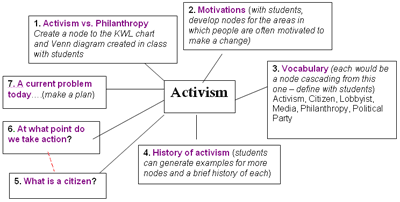
![]()
![]()
(covers #1, #2, and #3 in the main presentation)
Anticipatory Set- Sitting as a group, the teacher displays this question to spark students’ interest: “How big does a problem have to be for citizens to want to solve it?”
- Allow students five minutes to ponder this question with their neighbors, jotting down some ideas. As a group, discuss their ideas.
Introduce Philanthropy and Activism
- The teacher introduces the terms philanthropy and activism. As a group, discuss these terms and guide students in defining each term.
- On a chalkboard, overhead, or chart paper, the teacher will then create a Venn diagram. While the group discusses the qualities of an activist and a philanthropist, the teacher should fill in the qualities of each in the Venn diagram. Students can cite examples if they help define the terms. Students should record notes in their notebooks for later reference.
- The teacher will then create a KWL chart* of what students know about philanthropy and activism and what they want to know. (*A KWL chart is a chart with three columns. Write “K”, “W”, and “L” across the heading of each of the three columns. The “K” heading is for what students already know about a topic. The “W” is for what the students want to learn about the topic (that is, questions they have). Finally, the “L” is to be completed at the end of the unit. This is where the group can close the lesson and fill in what they learned about the topic.
- The teacher will then introduce the SpicyNodes nodemap as a method of organizing what students will learn in this unit of study. Optimally, the teacher will show/project the nodemap during the introduction. (As illustrated above, the items in purple will help students scaffold their topics of study.) Explain to students that they will use the SpicyNodes outline as a guide to explore the concept of activism. The students will be responsible for fleshing out and developing the SpicyNodes map to conduct a complete study of the concept of activism.
- The teacher will then present the idea that activism comes in many forms.
- From the introductory discussion of examples of activism and philanthropy, have students identify more examples of the different motivations for activism. Ideally, students will generate (with your guidance) the green terms below: political, social, and economic. Students should include the definition of that type of activism on its node (depicted as green in the example below), and examples in the next generation of nodes (depicted as blue under “economic activism,” below).
- In small groups, have students research definitions of each of the types and cite more examples of each type of activism. Each node will branch off one more time with examples of that type of activism and a brief summary of the activism. Students should record their findings in their notebooks.
- Select a few students to flesh out the types of activism and work this information into the SpicyNodes presentation at a computer station.
- The teacher should then introduce any remaining vocabulary terms required to complete this unit of study. In pairs, have students define the terms. Again, you can have the terms ready in your notes, and the students will provide the definitions as outlined in the SpicyNodes presentation.
- As a group, discuss the terms and their meanings, as well as how they relate to activism.
- Select a new small group of students to enter the defined terms into the SpicyNodes presentation at a computer station.
- Summarize the vocabulary related to activism, as well as the types of activism seen today.
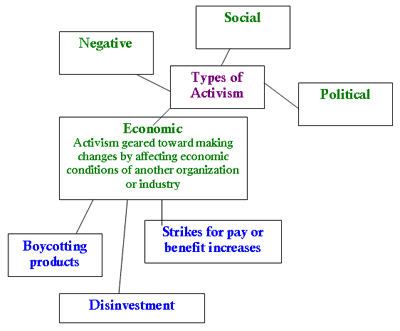
![]()
(covers #4 in the presentation)
Anticipatory Set- The teacher will begin by asking students if activism is a responsibility of a good citizen.
- As a class, consider a few instances of famous activism in the past (e.g. Boston Tea Party, 1968 Democratic National Convention riot, the Montgomery bus boycott, world revolutions, and so forth). Have student groups collaborate to identify such significant events. They should record notes on their discussion in their notebooks. What motivated these people to act? Revert back to question in #1 in the anticipatory set. Which of these movements are also examples of significant advances in American philanthropy?
- The teacher will then introduce the idea that activism is perceived differently by the people involved (refer to paragraph 5 of the “Teacher Background” section). Have students consider the different participants (those in power, the activists, other citizens, and so forth) when analyzing the historical events discussed earlier. For example, if discussing the American Revolution, is that activism considered positive? If so, by whom? Who might see that event as negative or controversial?
- At computer stations or in the computer lab, have students create a SpicyNodes nodule for each example of activism the students generate. It is helpful to have a list of examples. You can decide if you want these arranged by time period, by type of activism, by outcome, by perception, or some other categorization. There are many possibilities; what follows is an initial, brief sketch.
- While at computer stations, have students form small groups to research activist events and summarize what happened, what motivated the citizens, the outcome, and why the event is important in history. Include these on another generation of nodes. When time permits, each group should enter its event summary in the SpicyNodes presentation.
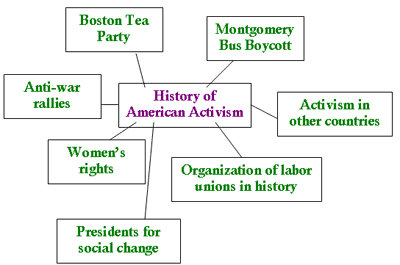
![]()
(covers #5 and #6 in the presentation)
Anticipatory Set- The teacher can begin by introducing the questions: What is a community? What factors help a community to function? What might cause a community to fail? What is a citizen? What are the responsibilities of a good citizen? See the green examples below for the course that brainstorming/discussion may take.
- In small groups, have student revisit the definition of a citizen and the responsibilities of an upstanding citizen. Students should elect a group recorder to note the main points of the discussion.
- Come together as large group and share the comments regarding the discussion of a citizen and a good citizen’s role in society. Students should record the main points in their notebooks.
- As a group, discuss the following: Revisit the definition of philanthropy; discuss how students can demonstrate good citizenship; determine who can help (mayor, officials, public departments, religious leaders, and so forth); discuss the options for making a difference in your community.
- In the computer lab, have the class decide on 4-5 nodes for the topic, “What is the citizen’s responsibility?” While at the computer work stations, have a new group of students enter these into the SpicyNodes presentation.
- As a class, discuss when citizens decide to take action. Review the historical activist events nodes. When did each of these groups decide to take action? What motivated them to take action? What seems to be the “limit” of human tolerance before action is taken? Is there a limit? For example, there seemed to be no limit when it came to the Holocaust. It seems as though sometimes events trigger activism, and other times charismatic leaders trigger activism.
- Allow plenty of time for this section, as this will likely promote a very engaging and meaningful discussion about how passion, fear, anger (or other emotions) play a significant role in one’s decision to become an activist or philanthropist. While still at the computer stations, have students incorporate their discussion into their node maps.
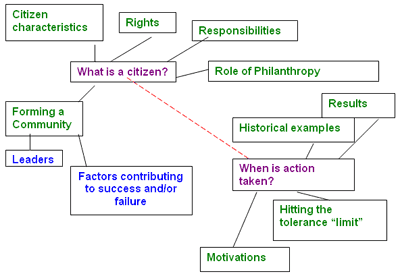
![]()
(covers # 7 in the presentation)
Anticipatory Set- The teacher should inform students that their local town is experiencing a dramatic decrease in recycling.
- In small groups, give students 10 minutes to brainstorm reasons why recycling is necessary. Students should jot down their brainstorming in the notebooks.
- The teacher will then assign two groups to each type of positive activism (two groups to political, two groups to economic, and two groups to social). Have students plan a way to utilize their type of activism to work toward solving the problem of declining recycling efforts. Remind students about the benefit of persuasive terms.
- The two groups for each type of activism then work as a team to combine, develop, and polish a plan. Possible related nodes are in green, below.
- In the computer lab, students should now use SpicyNodes to incorporate their campaign for each activist style under “A current issue today.”
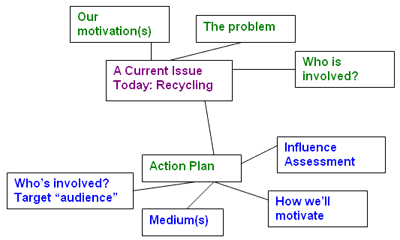
![]()
- Monitor participation during whole class discussion and small group work.
- Students work cooperatively to brainstorm and develop their activist plan.
- Students clearly include all points of their plan in the development of their nodes.
- Students use persuasive language to inform and convince the public of the need for increased recycling.


